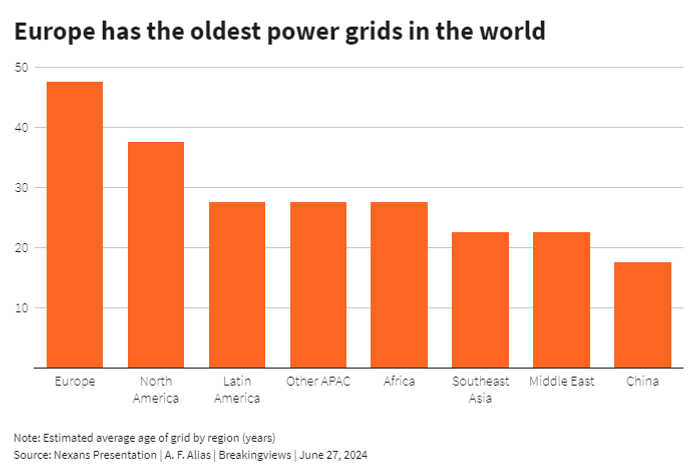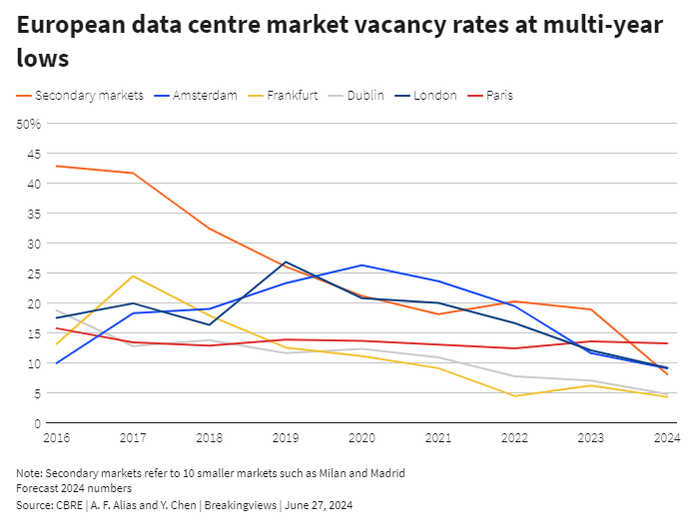Published 15:58 IST, July 4th 2024
Data centre boom reveals AI hype’s physical limits
The demand for data centre space in Europe’s five largest markets – Frankfurt, London, Amsterdam, Paris and Dublin – exceeded supply in the 1st quarter of 2024.
- Technology
- 6 min read

Power struggle. The craze in artificial intelligence has so far focused on chips made by Nvidia and apps like OpenAI’s ChatGPT. Underpinning this frenzy is a rush to build the infrastructure needed to train and run generative AI (GenAI) models. Nvidia CEO Jensen Huang predicts the sum invested in these data centres will double to $2 trillion in the next five years. Yet the world’s ability to construct, power and cool these facilities will determine the physical limits of the boom.
The real-world manifestation of the AI scramble is evident in the northern English county of Northumberland. That is where Blackstone, the world’s largest commercial real estate owner, in May bought 95 hectares of land with plans to spend 10 billion pounds ($13 billion) building one of Europe’s largest data centre campuses. The derelict site, which once housed a power plant, is first in line to be connected for electricity, according to a person familiar with the matter. Still, that depends on negotiations with Britain’s National Grid, and planning permissions from local authorities. Blackstone could yet walk away.
The seemingly insatiable appetite for AI contrasts with the more mundane challenges of building and operating data centres. These warehouse-like buildings which house servers and chips are measured by their demand for electricity. So-called “hyperscaler” data centers, which are mainly used for data storage and cloud computing services, typically have capacity of 20 to 50 megawatts.

The arrival of GenAI means greater processing power which requires more electricity. A ChatGPT text search consumes 10 times the power of a Google search, per Goldman Sachs analysts, while generating an image using a GenAI model could take as much energy as half a smartphone charge, according to a study by researchers at the AI startup Hugging Face and Carnegie Mellon University. Data centre operators are now planning and constructing facilities with capacity of 200 to 500 MW. Morgan Stanley analysts estimate the cost of building a campus at $10 million per megawatt.

These plans are testing energy infrastructure. Data centres, including those used to mine cryptocurrencies, sucked up about 460 terawatt hours (TWh), or 2% of global electricity demand in 2022, according to the International Energy Agency. In Europe, Morgan Stanley analysts estimate they will account for 4% of power demand by 2035, up from 1% today.
In some areas, however, the figure is much higher. Ireland, which is home to many large tech companies, has seen the proportion of its electricity consumed by data centres rise from 5% in 2015 to 18% in 2022. The figure is projected by EirGrid to hit 28% by 2031, prompting the state utility to place a moratorium on new data centres until 2028. By 2033, Goldman analysts expect AI data centres to add 370 TWh of power demand globally, equivalent to the combined power consumption of the United Kingdom and the Netherlands in 2023.

One potential solution is to build data centres in regions like Scandinavia, which have fewer people, a cooler climate, and an abundance of hydro power. But governments there are cautious. Sweden, once considered a prime destination for bitcoin miners in Europe, eliminated tax incentives for data centres last year, and started charging additional taxes on a per kilowatt hour (kWh) basis. A 2017 plan to build a 1,000 MW data centre – the world’s largest – in Norway collapsed after the government tweaked rules over reliefs on cryptocurrency miners.
Giant data centres in remote locations can perform the large numbers of calculations required to train AI models. When it comes to using applications like ChatGPT, however, physical proximity matters. A user who is 100 km away from an AI application’s servers will receive slower responses than one who is 10 km away. While a scientist may be willing to wait for more accurate queries, users looking for a better alternative to Google expect the same instant results.
Demand for nearby data centres will probably exceed the need for distant training ones. Schneider Electric estimates that the share of AI workload performed by such “inference” servers will reach 85% by 2028. These data centres are more likely to face challenges in terms of locating physical space, securing planning permission, and locking in adequate supplies of power.
One option is to repurpose existing facilities. This is far from straightforward, however. While established data centres rely on air conditioning to prevent servers from overheating, the more powerful chips used for GenAI may require direct liquid-to-chip cooling systems that are up to 10 times more expensive and require major design revamps. Nvidia’s newest graphics processing unit (GPU) may make retrofitting uneconomical, a European data centre operator told Breakingviews. The $3 trillion company dominates 75% of the market for GenAI chips.
The shortage of supply has prompted a land grab by deep-pocketed tech companies, former cryptocurrency miners like $19 billion CoreWeave, and investment firms like Brookfield Asset Management, EQT and PGIM, the asset management unit of Prudential Financial. In June alone, Microsoft pledged $3.2 billion on Swedish data centres and another $7 billion in Spain. There is also a scramble to find alternative sources such as geothermal electricity. OpenAI CEO Sam Altman has proposed that AI’s energy needs be met by nuclear fusion.

The combination of rampant demand and constrained supply promise a bonanza for landlords leasing data centres to tech firms. Investors in new projects will not break ground without demanding a yield, calculated as expected income as a proportion of development costs, of at least 8% to 10%. That is about 5 percentage points more than the likely return on acquiring an existing data centre, according to one senior real estate executive.
The knock-on effect of these costs pushes up the revenue that AI operators will need to recoup from their customers. It also leaves them with less margin for error. The extent of the AI boom may depend as much on the sophistication of self-teaching models as on the ability of data centre operators to overcome their physical limitations.
Context News
The demand for data centre space in Europe’s five largest markets – Frankfurt, London, Amsterdam, Paris and Dublin – exceeded supply in the first quarter of 2024, real estate services provider CBRE said in a report published on May 17. Microsoft plans to invest 6.69 billion euros ($7.16 billion) to develop new data centres in Spain’s northeastern region of Aragon, Reuters reported on June 14. Aragon’s regional government said the U.S. tech giant had applied for a construction permit to build data centres at a site outside the city of Zaragoza, according to the report.
Updated 15:58 IST, July 4th 2024